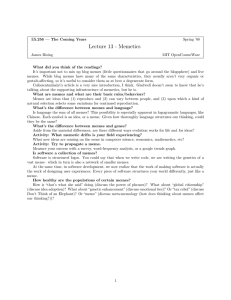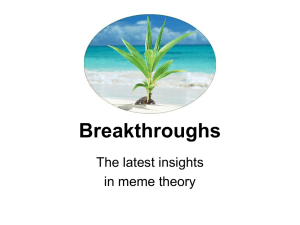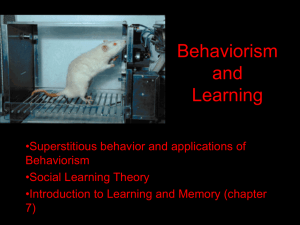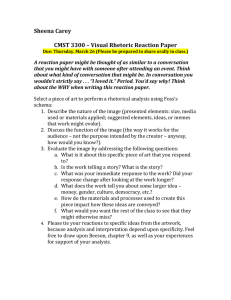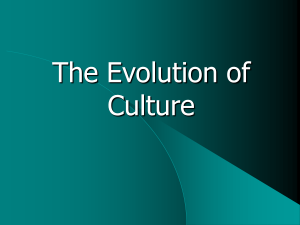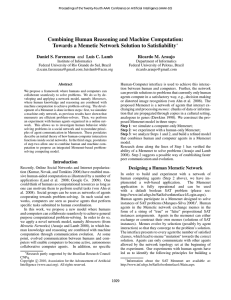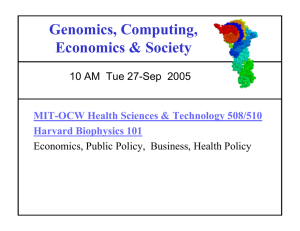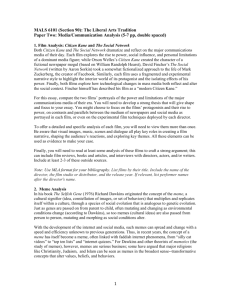Internet memes: transnational products of (home
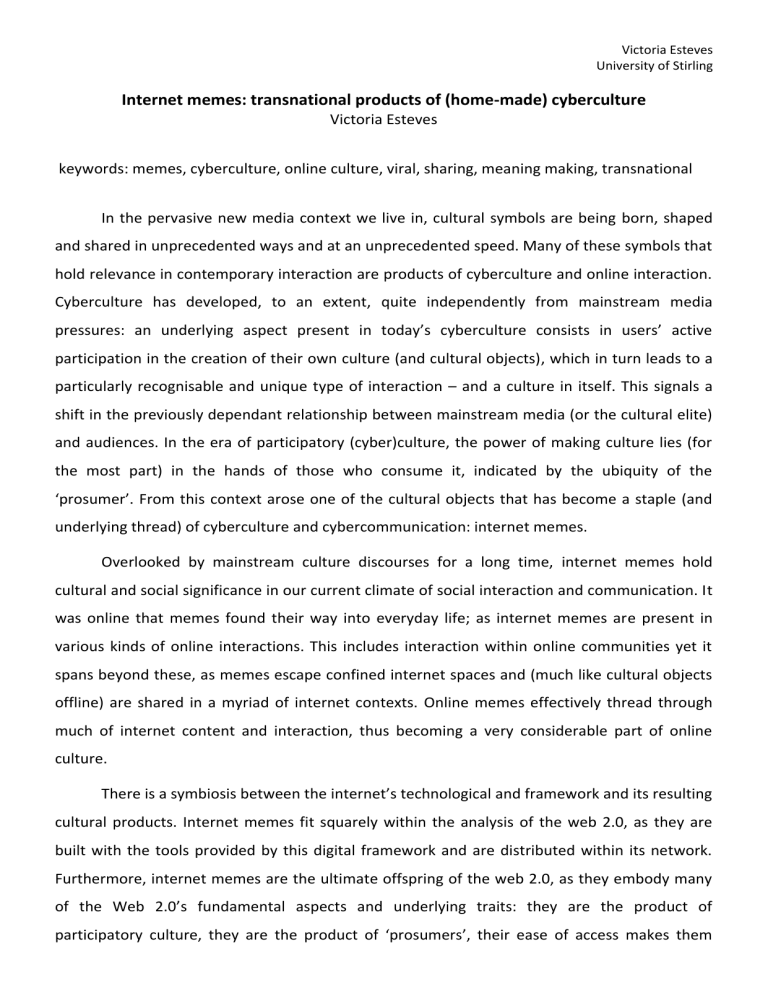
Victoria Esteves
University of Stirling
Internet memes: transnational products of (home-made) cyberculture
Victoria Esteves
keywords: memes, cyberculture, online culture, viral, sharing, meaning making, transnational
In the pervasive new media context we live in, cultural symbols are being born, shaped and shared in unprecedented ways and at an unprecedented speed. Many of these symbols that hold relevance in contemporary interaction are products of cyberculture and online interaction.
Cyberculture has developed, to an extent, quite independently from mainstream media pressures: an underlying aspect present in today’s cyberculture consists in users’ active participation in the creation of their own culture (and cultural objects), which in turn leads to a particularly recognisable and unique type of interaction – and a culture in itself. This signals a shift in the previously dependant relationship between mainstream media (or the cultural elite) and audiences. In the era of participatory (cyber)culture, the power of making culture lies (for the most part) in the hands of those who consume it, indicated by the ubiquity of the
‘prosumer’. From this context arose one of the cultural objects that has become a staple (and underlying thread) of cyberculture and cybercommunication: internet memes.
Overlooked by mainstream culture discourses for a long time, internet memes hold cultural and social significance in our current climate of social interaction and communication. It was online that memes found their way into everyday life; as internet memes are present in various kinds of online interactions. This includes interaction within online communities yet it spans beyond these, as memes escape confined internet spaces and (much like cultural objects offline) are shared in a myriad of internet contexts. Online memes effectively thread through much of internet content and interaction, thus becoming a very considerable part of online culture.
There is a symbiosis between the internet’s technological and framework and its resulting cultural products. Internet memes fit squarely within the analysis of the web 2.0, as they are built with the tools provided by this digital framework and are distributed within its network.
Furthermore, internet memes are the ultimate offspring of the web 2.0, as they embody many of the Web 2.0’s fundamental aspects and underlying traits: they are the product of participatory culture, they are the product of ‘prosumers’, their ease of access makes them
Victoria Esteves
University of Stirling inherently democratic, they rely on collaborative circulation to propagate (O’Reilly 2005; Jenkins
2006: 3, Bruns 2008: 2; Grinnell 2009: 597, Leadbeater 2009: 19; Shirky 2010: 25; Meikle &
Young 2012: 125).
Internet memes exacerbate the role of the network (and its place in the ‘network society’ we currently live in (see Castells 2000)); as, in participatory culture, making is just half of the ethos; sharing is the other half (Meikle & Young 2012: 125). There is no point in making a lolcat and not sharing it – and we want to share them because they mean something to us, they might mean something to a relationship between two people or they might mean something for the users of a global forum (Rowell 2011: 14; boyd 2012: 76). As Leadbeater puts it, ‘in the economy of ideas that the web is creating, you are what you share’ (2009: 6). This sharing process not only signifies the affordances allowed by the network and its space of flows (Castells 2000: 407)
– which has gained a new momentum within the Web 2.0 environment (Grinnell 2009: 580) – and its importance in the dissemination of memes (Everitt & Mills 2009: 752); but it also signals to the meaningfulness this content gains when shared: to share an internet meme is to connect, whether it is with someone in your personal circle or the whole world (Rowell 2011: 14).
In order to analyse internet memes, there are several theoretical issues to be considered.
At a basic level lies the (pre-internet) concept of memes. Internet memes are grounded on the original concept of the meme coined by Dawkins (1976). Memes have been around since the dawn of time, but perhaps because they are so pervasive, they become almost taken for granted and not much academic focus is given to this area. The term arose from a biological field of study, meant to be a non-genetic counterpart of the word ‘gene’ (i.e. memes are all the things – ideas, concepts, abstractions, culture – that are not passed on via genetics) (Dawkins
1976). This places this concept in a field that is far from media and culture; which is reflected in the amount of published works that deal with memetics that come from a scientific arena. Many works that address memetics place it squarely within the biological field of study – at times dealing with memes on an almost physical level, which is the case of influential books like ‘The electric meme’ (Aunger 2010) and Susan Blackmore’s (1999) works.
Though internet memes are still memes in the broader sense of the word, they have also come to signify something quite different (and specific) – whilst the meme as depicted by
Victoria Esteves
University of Stirling
Dawkins (1976), Blackmore (1999) and Aunger (2010) (among other scientists) is an obscure academic concept, internet memes are a commonplace distinctly non-academic term that is accessible to a wide variety of people (Deibert & Rohozinski 2010: 32; Tyler 2011: 47) - to the point where many people are not familiar with the origin of the word or its initial concept (or even definition). Beyond this biological framework, internet memes function as a vehicle for cultural meaning-making and a symbol of democratic power (as well as representing a shift in established media forms of creation, consumption and reception), thus calling for literature in these areas instead.
Although internet memes have been enjoying a growing fame worldwide (and although the topic of digital communication – and indeed the topic of social communication within the convergent media atmosphere – has been receiving large amounts of focus (Zheleva et al. 2010:
97; Kumar, Novak and Tomkins 2010: 338)), with the exception of Davison (2012), there has been very little academic research that focuses on this particular aspect of online communication. This lack of academic attention given to internet memes (Davison 2012: 120,
122) (as opposed to the growing interest in more ‘established’ forms of internet use usually related to news or knowledge, such as citizen journalism (see Allan & Thorsen 2009;
Papacharissi 2009; Djajalie 2011) and Wikipedia (see Bruns 2008; Lih 2009; O'Sullivan 2009)) signals to the dismissal of internet memes as superfluous. This indicates a lack of perception that is akin to early dismissals of media studies in general - let us bear in mind, that media itself has been around for a long time, yet the academic interest in media is relatively contemporary
(O’Connor 2006: 15).
As aforementioned, internet memes interlink many relevant aspects of (current) media, such as embodying the possibilities afforded by the Web 2.0. Resting on an ‘architecture of participation’ (O’Reilly 2005; Meikle & Young 2012: 125), the Web 2.0 originated a new era of interaction (Gauntlett 2011: 7); one where (albeit not being a new notion (Grinnell 2009: 579;
Shirky 2010: 19)) the term ‘participatory culture’ began to arise (Jenkins 2006: 3). Users were now not seen as passive consumers, but as active producers themselves; leading to new concepts such as the ‘produser’ (i.e. producer/user) (Bruns 2008: 2; Grinnell 2009: 597).
Entrenched in both the computer (Shirky 2010: 22) and the internet (Leadbeater 2009: 6;
Gauntlett 2011: 77), the idea of user participation thrived online because of how widespread it
Victoria Esteves
University of Stirling could be: anyone (with access to a networked computer) could participate in creation (and share it) on a global-scale (Leadbeater 2009: 19; Shirky 2010: 25; Gauntlett 2011: 3) – something that goes against the very grain of older forms of media that are still organized around gatekeeping (Leadbeater 2009: xvii; Shirky 2010: 46).
Yet memes are still commonly reduced to the category of insignificant internet drivel
(Labash 2012). However, despite being criticized for their simplicity, it is exactly this aspect that makes them entirely democratic (echoing the democratic values of the web 2.0, which includes more complex examples like citizen journalism). As Shirky puts it ‘anyone seeing a lolcat gets a second, related message: You can play this game too’ (Shirky 2010: 18) – no matter how simple a lolcat is, it is still undeniably a creative act that can be made by anyone and shared with millions of people around the world. This is something that critics don’t seem to grasp – the point isn’t that memes have to or even should be good in terms of quality, the point is that we can participate in the active making and sharing of these. There is a track record of acceptance of amateur content within online spaces, as online culture itself is an ongoing process of development, a perpetual beta (a symbol of the Web 2.0 itself). So even something as basic as making a lolcat isn’t a worthless activity – it could be argued it’s more relevant than watching an entire lifetime worth of television, as the lolcat allows us the freedom to make our own content, to share it ourselves, to make us creative and (inter)active in a way that television was only ever able to do in a limited form (Shirky 2010: 18, 172). Furthermore, these imperfect and simple memes are both originated and appreciated by the cyber citizens that inhabit online spaces; they are ultimately very much a product of online culture that accepts and welcomes memes’ properties of propagation, ease of access, and perpetual beta-ness. Additionally, internet memes are also able to overcome national and political barriers and do so almost instantaneously. Whilst the language (and text) accompanying the meme might change, the connotation behind the visual image of the meme does not – making memes an easy cybercultural tool to communicate a range of meanings on a global scale.
Internet memes allow meaning making to be placed in the direct hands of the people whilst also celebrating remix culture. As with everything else in the media, it is also important to place this type of activity within a previously existing framework. Despite being commonly heralded as such, remix culture is not new and has revealed itself in many ways, from cut and
Victoria Esteves
University of Stirling paste collage to the reworking of common symbols – a link that has been acknowledged in the literature (Lievrouw 2013). Before internet memes there was the use of détournement by the avant-garde Situationist International movement (Debord 1957) which subverted messages by reworking the original references (Meikle 2008: 374); the Dada movement which used collage as a form of artistic subversion (Olivier 2009: 130); the punk movement’s subversive appropriation of symbols (During 2005: 126) and everyday objects (Bennett 2013: 573); as well as craft and DIY groups (Gauntlett 2011).
Some of these forms of remix – such as the punk movement, craft groups and others – additionally emphasise the imperfect work of amateurs – to these groups, what matters is participation in itself, the power to make and to do so collectively (Jacobson 2010: 32; Gauntlett
2011). Internet memes are, then, the online counterpart of these activities, as they celebrate this imperfection and herald the ability to make (collectively) instead; at a considerably larger and more global level, whilst also demanding much less from those who wish to partake in these collectively remixed activities.
By focusing on the phenomena of internet memes, one can also explore the relationships between audiences, texts and their circulation within the digital framework. I believe that internet memes are able to translate aptly these relations. Audience reception studies come into play here and demonstrate that television viewers aren’t necessarily passive recipients (see
Hall 2005; Morley 2005: 17), as television audiences do not passively accept content; instead they receive content and negotiate it accordingly, making their own interpretation from the content they receive (Brooker & Jermyn 2003: 91; Procter 2004: 69,70; Hall 2005: 109). Even though this forms the basis of how audiences began to be seen as active meaning-makers, the tools Web 2.0 has granted the audience has led it to gain more power than ever before –
‘prosumers’ are, then, an almost utopian extension of the active audience that was observed by
Hall (2005) and Morley (2005).
In an increasingly networked society, cultural symbols are gaining a cultural and sociological weight that has surpassed the delimitations of the internet and are beginning to take a very real and palpable presence in our offline lives. This malleability and ubiquity of cyberculture has translated beyond online borders, as internet memes are increasingly found in
Victoria Esteves
University of Stirling offline places. One of the uses that memes have had in the palpable world is that of soap box to voice political and social discontent: memes are being increasingly featured (and, subsequently, re-appropriated) in protest billboards made by citizens around the world in order to challenge dominant powers. This not only points towards the relevance of internet memes on a global and very ‘real’ sense, but it also signals a direct participation in politics – and an undeniable act of democratic engagement. Additionally, having products of online culture featured in such contexts further evidences the impact of cyberculture in (both online and offline) everyday life.
Throughout my research I have been adamant regarding the destruction of the imaginary boundary that has been established between the virtual and physical world (sometimes misguidedly referred to as the ‘real world’), which can be achieved by memes. Internet memes have found their way into the palpable world and are being re-appropriated by citizens and
‘prosumers’. Much like remix culture, this sort of internet activism has its (older) offline counterpart: craftivism. David Gauntlett (2011) reinforces the parallel between the democratic actions that take place online - such as the ability to make and distribute media content (e.g. internet memes) – and this offline counterpart of the art of (political) craft. This relation between media and action is, to some extent, also echoed in Meikle & Young’s (2012) argument that reinforces media is something we make and engage with ourselves. The rise of citizen activism and the heavy use and attention given to internet and participatory culture in recent political elections comes to illustrate this point.
Be it by their astonishing online dissemination or their visible offline presence, internet memes represent the act of meaning-making that is placed in the hands of the people – for the first time in a long time, it is the people (not corporations or governments) that are directly dictating what is meaningful through these memes that they make and share. Memes are also a living testament to the influence and impact of online culture in everyday life, be it within the realm of the internet or in the palpable (offline) world.
Victoria Esteves
University of Stirling
Bibliography
Aunger, R. (2010). The electric meme: a new theory of how we think.
New York: Free Press.
Bennett, A. (2013). Youth Culture, Leisure and Lifestyle: From Subcultures to Post-Subcultures. In T. Blackshaw,
Routledge Handbook of Leisure Studies (pp. 571-583). New York: Routledge.
Blackmore, S. (1999). The Meme Machine. Oxford: Oxford University Press. boyd, d. (2012). Participating in the Always-On Lifestyle. In M. Mandiberg, The Social Media Reader (pp. 71-76).
New York: New York University Press.
Brooker, W., & Jermyn, D. (2003). The Audiences Study Reader. London: Routledge.
Bruns, A. (2008). Blogs, Wikipedia, Second Life, and Beyond - From Production to Produsage. New York: Peter
Lang Publishing.
Davison, P. (2012). The Language of Internet Memes. In M. Mandiberg, The Social Media Reader (pp. 120-134).
New York University Press: New York.
Dawkins, R. (1976). The Selfish Gene. Oxford: Oxford University Press.
Debord, G. (1957, June). Report on the Construction of Situations and on the International Situationist Tendency's
Conditions of Organization and Action.
Retrieved April 23, 2013, from Situationist International Online: http://www.cddc.vt.edu/sionline/si/report.html
Deibert, R., & Rohozinski, R. (2010). Control and Subversion in Russian Cyberspace. In R. Deibert, Access controlled: the shaping of power, rights, and rule in cyberspace (pp. 15-34). Massachusetts:
Massachusetts Institute of Technology.
Djajalie, K. (2011). Citizen Journalist: A Case Study on Using Blogs for Self-Promotion.
Singapore: Solstice
Publishing.
During, S. (2005). Cultural Studies: a critical introduction.
New York: Routledge.
Everitt, D., & Mills, S. (2009). Cultural anxiety 2.0. Media, Culture & Society, 31 (5).
Gauntlett, D. (2011). Making is Connecting - The Social Meaning of Creativity, from DIY and Knitting to Youtube and Web 2.0. Cambridge: Polity Press.
Grinnell, C. (2009). From Consumer to Prosumer to Produser: Who Keeps Shifting My Paradigm? (We Do!). Public
Culture, 21 (3).
Hall, S. (2005). Introduction to Media Studies at the Centre. In S. Hall, D. Hobson, A. Lowe, & P. Willis, Culture,
Media, Language (pp. 104-109). London: Routledge.
Jacobson, E. (2010). Music Remix in the Classroom. In C. L. Michele Knobel, DIY Media: Creating, Sharing and
Learning With New Technologies (pp. 27-50). New York: Peter Lang Publishing.
Jenkins, H. (2006). Convergence Culture - Where Old and new Media Collide. New York: New York University
Press.
Kumar, R., Novak, J., & Tomkins, A. (2010). Structure and Evolution of Online Social Networks. In J. Han, & C.
Faloutsos, Link Mining: Models, Algorithms, and Applications (pp. 337-358). New York: Springer.
Labash, M. (2012, June 4). The Meme Generation . Retrieved May 15, 2013, from The Weekly Standard: http://www.weeklystandard.com/articles/meme-generation_645912.html
Victoria Esteves
University of Stirling
Leadbeater, C. (2009). We Think - Mass Innovation, Not Mass Production. London: Profile Books Ltd.
Lievrouw, L. (2011). Alternative and Activist New Media.
Cambridge: Polity Press.
Lih, A. (2009). The Wikipedia revolution: how a bunch of nobodies created the world's greatest encyclopedia.
Michigan: Hyperion.
Meikle, G. (2008). Whacking Bush: Tactical Media as Play. In M. Boler, Digital Media and Democracy: Tactics in
Hard Times (pp. 367-382). Massachusetts: MIT Press.
Meikle, G., & Young, S. (2012). Media Convergence - Networked Digital Media in Everyday Life. Basingstoke:
Palgrave Macmillan.
Morley, D. (2005). Television, Audiences and Cultural Studies.
New York: Taylor & Francis Group.
O'Connor, A. (2006). Key thinkers in Critical Media Studies: Raymond Williams.
Oxford: Rowman & Littlefield
Publishers Inc.
O'Reilly, T. (2005, September 30). What is Web 2.0? Design Patterns and Business Models for the Next Generation of Software. Retrieved May 12, 2012, from O'Reilly Media: http://oreilly.com/web2/archive/what-is-web-20.html
O'Sullivan, D. (2009). Wikipedia: A New Community of Practice?
Surrey: Ashgate Publishing.
Olivier, B. (2009). Philosophy and the Arts: Collected Essays.
Bern: Peter Lang.
Papacharissi, Z. (2009). Journalism and Citizenship: New Agendas in Communication.
New York: Routledge.
Procter, J. (2004). Stuart Hall. London: Routledge.
Rowell, R. (2011). YouTube: The Company and Its Founders.
Minnesota: ABDO.
Shirky, C. (2010). Cognitive Surplus - Creativity and Generosity in a Connected Age. London: Penguin Books.
Tyler, T. (2011). Memetics: Memes and the Science of Cultural Evolution.
Mersenne Publishing.
Zheleva, E., Getoor, L., Golbeck, J., & Kuter, U. (2010). Using Friendship Ties and Family Circles for Link Prediction.
In L. Giles, M. Smith, J. Yen, & H. Zhang, Advances in Social Network Mining and Analysis: Second
International Workshop, SNAKDD 2008, Las Vegas, NV, USA, August 24-27, 2008 (pp. 97-113). Berlin:
Springer.
